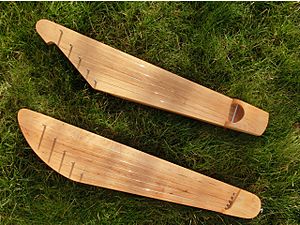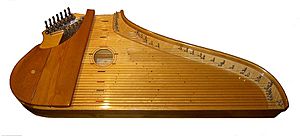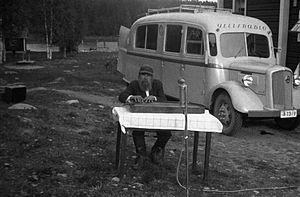Kantele facts for kids
A kantele is a cool, traditional string instrument from Finland and Karelia. It's played by plucking its strings. Think of it like a harp or a zither.
The kantele is part of a family of instruments called the Baltic psaltery. These instruments are found around the southeastern Baltic Sea. Other instruments in this family include the Estonian kannel, the Latvian kokles, the Lithuanian kanklės, and the Russian gusli.
Contents
How Kanteles Are Made
Small Kantele
Older kanteles were often carved from a single piece of wood. They had just five or six strings, usually made from horsehair. Today, small kanteles often have metal strings. They can have up to 15 strings. These instruments look a lot like the traditional ones.
A traditional kantele doesn't have a special bridge or nut. The strings go straight from the tuning pegs to a metal bar. This design helps give the kantele its unique sound.
Concert Kantele
A modern concert kantele is much bigger. It can have up to 40 strings! When you play a small kantele, the longest strings are usually farthest from you. But on a concert kantele, the longest, low-pitched strings are closest to your body. The shorter, high-pitched strings are farther away.
Concert kanteles also have special switches. These switches let players easily change notes to sharps or flats. This cool feature was added by Paul Salminen in the 1920s. It's similar to how some modern harps work.
Playing the Kantele
The kantele makes a beautiful, bell-like sound. Most Finnish kanteles are tuned to a diatonic scale. This means they play notes like a piano's white keys. Smaller kanteles might have a special tuning. They might be missing a few notes or have a drone string.
Players usually hold the kantele on their lap or on a small table. There are two main ways to play. You can pluck the strings with your fingers. Or you can strum them. Sometimes, players even use a matchstick to strum! Small and concert kanteles have different kinds of music they are best for.
Kantele Music Today

The kantele has become very popular in Finland since the mid-1900s. Players like Martti Pokela helped bring it back into the spotlight. You can learn to play the kantele in schools and music academies. Even the famous Sibelius Academy in Finland teaches it.
A Finnish company called Koistinen Kantele has even created an electric kantele. It uses special parts called pickups, just like an electric guitar. This electric kantele has become popular with Finnish heavy metal bands, like Amorphis.
The Kantele in Legends

In Finland's national story, the Kalevala, there's a cool legend about the kantele. A wise old mage named Väinämöinen makes the very first kantele. He uses the jawbone of a giant pike fish and some hairs from a magical horse.
When Väinämöinen plays this kantele, its music is so beautiful that all the forest animals come to listen. Later, he loses his first kantele. So, he makes another one from birch wood. He strings it with hair from a kind maiden. This new kantele also has amazing magic. The legend says Väinämöinen leaves this magical kantele behind when he leaves Finland.
See also
 In Spanish: Kantele para niños
In Spanish: Kantele para niños





